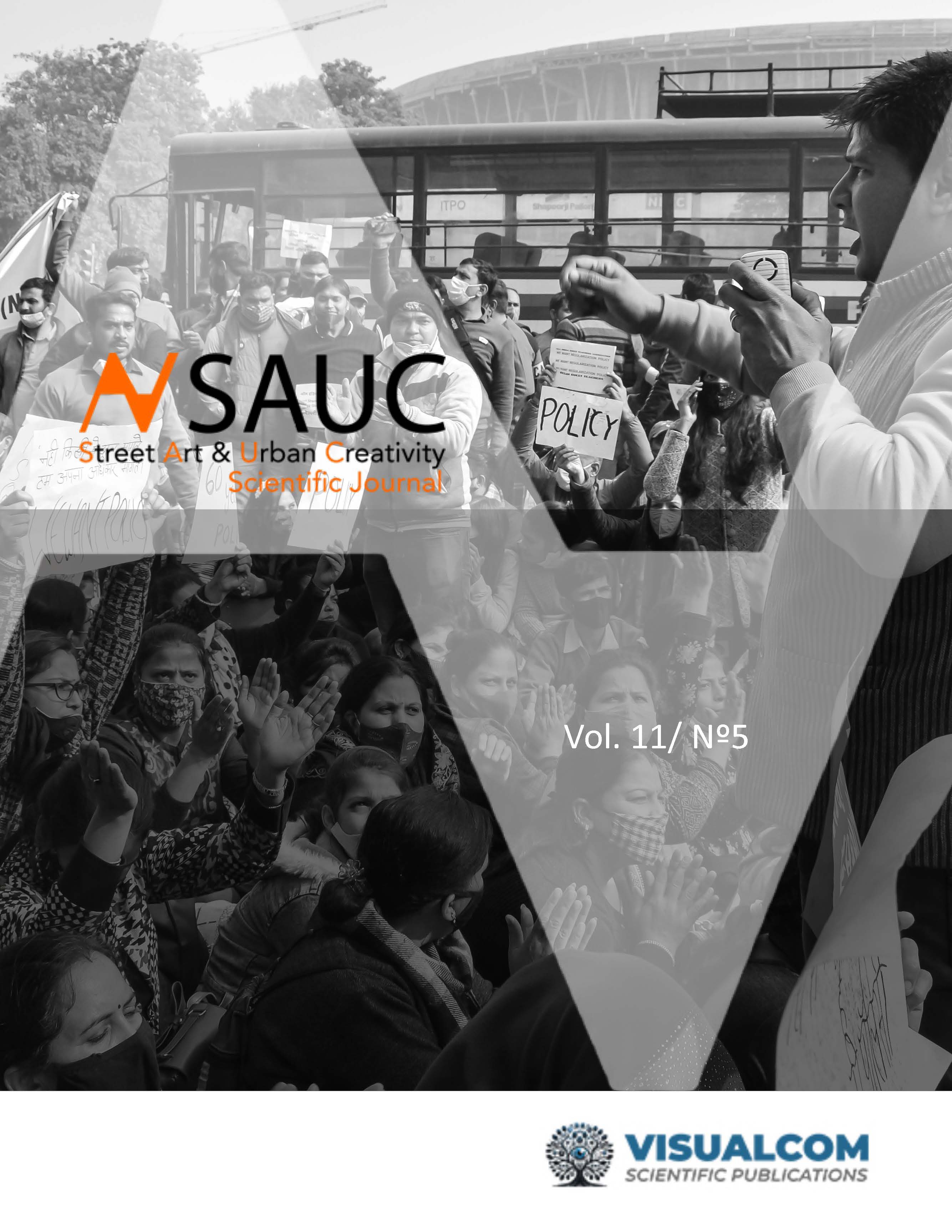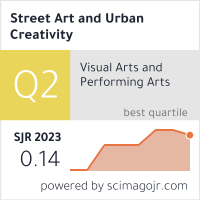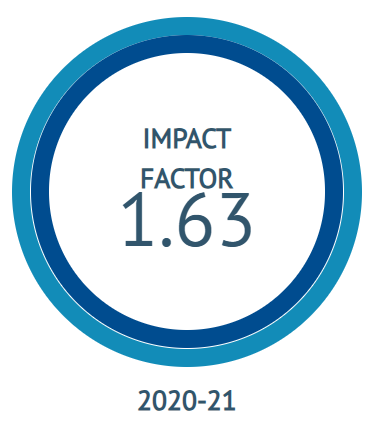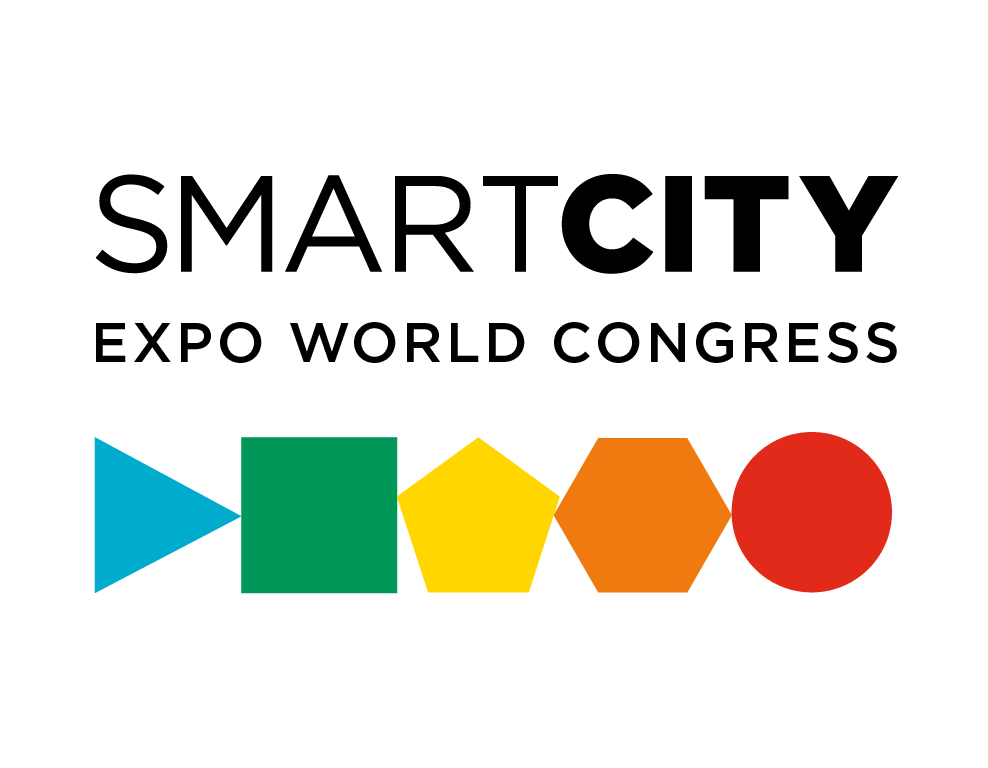Arte urbano e identidad de la marca-barrio
El caso de Lavapiés y su representación en Instagram
DOI:
https://doi.org/10.62161/sauc.v11.5642Palabras clave:
Marca lugar, Marca barrio, Arte urbano, Identidad urbana, Instagram, UGC, LavapiésResumen
Este estudio examina cómo el arte urbano, a través de las publicaciones de usuarios en Instagram (UGC), contribuye a la creación de la identidad de marca-lugar de un barrio. Focalizándonos en el barrio de Lavapiés en Madrid, se realizó un análisis de contenido de las publicaciones etiquetadas con #Lavapiés. Los resultados revelan que el arte urbano es el tema más frecuente en las publicaciones, destacando su conexión primordial con la gastronomía y la vida social del barrio. Sin embargo, se observa una desvinculación significativa entre el arte urbano y la participación política o ciudadana, lo que sugiere una asimilación de este tipo de arte en la vida cotidiana, alejándose de su potencial reivindicativo. El estudio concluye con una reflexión sobre el rol subestimado de las instituciones en la configuración de la marca-lugar.
Descargas
Estadísticas globales ℹ️
|
406
Visualizaciones
|
228
Descargas
|
|
634
Total
|
|
Citas
Acuti, D., Mazzoli, V., Donvito, R., & Chan, P. (2018). An instagram content analysis for city branding in London and Florence. Journal of Global Fashion Marketing, 9(3), 185-204. https://doi.org/10.1080/20932685.2018.1463859
Ana, M.-I., & Istudor, L.-G. (2013). The Role of Social Media and User-Generated-Content in Millennials’ Travel Behavior. Management Dynamics in the Knowledge Economy, 7(1), 87-104. https://doi.org/10.25019/MDKE/7.1.05
Ashworth, G. J. (2009). The Instruments of Place Branding: How is it Done? European Spatial Research and Policy, 16(1), 9-22. https://doi.org/10.2478/v10105-009-0001-9
Ashworth, G., & Kavaratzis, M. (2009). Beyond the logo: Brand management for cities. Journal of Brand Management, 16(8), 520-531. https://doi.org/10.1057/palgrave.bm.2550133
Austin, J. (2010). More to see than a canvas in a white cube: For an art in the streets. City, 14(1-2), 33-47. https://doi.org/10.1080/13604810903529142
Baumann, F., Lopes, M. S., & Lourenço, P. (2018). Destination image through digital photography. Instagram as a data collector for UGC analysis. E-Review of Tourism Research, 9. https://ertr-ojs-tamu.tdl.org/ertr/article/view/117
Blanché, U. (2015). Street Art and related terms. SAUC - Street Art & Urban Creativity Scientific Journal, 1(1), 32-39. https://doi.org/10.25765/SAUC.V1I1.14
Bonfigli, F. (2014). Lavapiés: Seguridad urbana, activismo politico y inmigracion en el corazon de Madrid. Sortuz: Oñati Journal of Emergent Socio-Legal Studies, 6(2), 61-77. https://opo.iisj.net/index.php/sortuz/article/view/547
Chaskin, R. J. (1997). Perspectives on Neighborhood and Community: A Review of the Literature. Social Service Review, 71(4), 521-547. https://doi.org/10.1086/604277
Chaskin, R. J. (1998). Neighborhood as a Unit of Planning and Action: A Heuristic Approach. Journal of Planning Literature, 13(1), 11-30. https://doi.org/10.1177/088541229801300102
Christensen, M., & Thor, T. (2017). The reciprocal city: Performing solidarity—Mediating space through street art and graffiti. International Communication Gazette, 79(6-7), 584-612. https://doi.org/10.1177/1748048517727183
Cócola-Gant, A. (2016). Holiday Rentals: The New Gentrification Battlefront. Sociological Research Online, 21(3), 112-120. https://doi.org/10.5153/sro.4071
Cocola-Gant, A., Hof, A., Smigiel, C., & Yrigoy, I. (2021). Short-term rentals as a new urban frontier – evidence from European cities. Environment and Planning A: Economy and Space, 53(7), 1601-1608. https://doi.org/10.1177/0308518X211042634
Collins, B. (2021). Place Branding and Its Discontents: The Politics and Management of Neighborhood Governance Systems. Journal of Planning Education and Research, 44(2) 0739456X2199844. https://doi.org/10.1177/0739456X21998448
DeGiovanni, F. F. (1983). Patterns of Change in Housing Market Activity in Revitalizing Neighborhoods. Journal of the American Planning Association, 49(1), 22-39. https://doi.org/10.1080/01944368308976193
DeGiovanni, F. F., & Paulson, N. A. (1984). Household Diversity in Revitalizing Neighborhoods. Urban Affairs Quarterly, 20(2), 211-232. https://doi.org/10.1177/004208168402000206
Eshuis, J., & Edelenbos, J. (2009). Branding in urban regeneration. Journal of Urban Regeneration and Renewal, 2(3), 272-282. https://doi.org/10.69554/NUYS8388
Eshuis, J., Klijn, E.-H., & Braun, E. (2014). Place marketing and citizen participation: Branding as strategy to address the emotional dimension of policy making? International Review of Administrative Sciences, 80(1), 151-171. https://doi.org/10.1177/0020852313513872
García, B. (2004). URBAN REGENERATION, ARTS PROGRAMMING AND MAJOR EVENTS: Glasgow 1990, Sydney 2000 and Barcelona 2004. International Journal of Cultural Policy, 10(1), 103-118. https://doi.org/10.1080/1028663042000212355
Gilboa, S., Jaffe, E. D., Vianelli, D., Pastore, A., & Herstein, R. (2015). A summated rating scale for measuring city image. Cities, 44, 50-59. https://doi.org/10.1016/j.cities.2015.01.002
Gon, M. (2021). Local experiences on Instagram: Social media data as source of evidence for experience design. Journal of Destination Marketing & Management, 19, 100435. https://doi.org/10.1016/j.jdmm.2020.100435
González-Díez, L., & Bengoa, M. T. (2018). La intervención artística en el espacio urbano: Acción y reflexión de “Muros Tabacalera". Arquetipo, 17, 49-61.
Grodach, C. (2011). Art Spaces in Community and Economic Development: Connections to Neighborhoods, Artists, and the Cultural Economy. Journal of Planning Education and Research, 31(1), 74-85. https://doi.org/10.1177/0739456X10391668
Hanna, S., & Rowley, J. (2008). An analysis of terminology use in place branding. Place Branding and Public Diplomacy, 4(1), 61-75. https://doi.org/10.1057/palgrave.pb.6000084
Hannerz, E. (2016). Scrolling down the line. SAUC - Street Art and Urban Creativity, 2(2). https://doi.org/10.25765/sauc.v2i2.50
Hochman, N., & Manovich, L. (2013). Zooming into an Instagram City: Reading the local through social media. First Monday, 18(7). https://doi.org/10.5210/fm.v18i7.4711
Hudson, J. R. (1980). Revitalization of Inner-City Neighborhoods: An Ecological Approach. Urban Affairs Quarterly, 15(4), 397-408. https://doi.org/10.1177/107808748001500403
Hwang, K. H. (2014). Finding Urban Identity through Culture-led Urban Regeneration. Journal of Urban Management, 3(1-2), 67-85. https://doi.org/10.1016/S2226-5856(18)30084-0
Kádár, B., & Klaniczay, J. (2022). Branding Built Heritage through Cultural Urban Festivals: An Instagram Analysis Related to Sustainable Co-Creation, in Budapest. Sustainability, 14(9). https://doi.org/10.3390/su14095020
Kusumowidagdo, A., Ujang, N., Rahadiyanti, M., & Ramli, N. A. (2022). Exploring the sense of place of traditional shopping streets through Instagram’s visual images and narratives. Open House International, 48(1), 2-22. https://doi.org/10.1108/OHI-01-2022-0009
Lemoine-Rodríguez, R., Inostroza, L., & Zepp, H. (2020). The global homogenization of urban form. An assessment of 194 cities across time. Landscape and Urban Planning, 204, 103949. https://doi.org/10.1016/j.landurbplan.2020.103949
Luque Rodrigo, L., & Moral Ruiz, C. (2022). The complex task of cataloguing street and public art. CAP - Public Art Journal, 3(1), 36-49. https://doi.org/10.48619/CAP.V3I1.468
Luque-Rodrigo, L. (2020). La gestión del arte urbano, ¿una cuestión pendiente? La Colmena, 81. https://doi.org/10.36677/lacolmena.v0i106.13191
Martin, J. A., & Pentel, P. R. (2002). What the Neighbors Want: The Neighborhood Revitalization Program’s First Decade. Journal of the American Planning Association, 68(4), 435-449. https://doi.org/10.1080/01944360208976284
Masuda, J. R., & Bookman, S. (2018). Neighbourhood branding and the right to the city. Progress in Human Geography, 42(2), 165-182. https://doi.org/10.1177/0309132516671822
Meléndez Táboas, A. (2013). Ilustradores de pared en Madrid. Arte y Ciudad: Revista de Investigación, 3(1), 569-586.
Miles, M. (1995). Art and urban regeneration. Urban History, 22(2), 238-252. https://doi.org/10.1017/S096392680000050X
Narangajavana, Y., Callarisa Fiol, L. J., Moliner Tena, M. Á., Rodríguez Artola, R. M., & Sánchez García, J. (2017). The influence of social media in creating expectations. An empirical study for a tourist destination. Annals of Tourism Research, 65, 60-70. https://doi.org/10.1016/j.annals.2017.05.002
Nomeikaite, L. (2017). Street art, heritage and embodiment. SAUC - Street Art and Urban Creativity, 3(1), 43-53. https://doi.org/10.25765/sauc.v3i1.62
Nur’afifah, O., & Prihantoro, E. (2021). The Influence of Social Media on Millennial Generation about Travel Decision-Making. Jurnal The Messenger, 13(3). https://doi.org/10.26623/themessenger.v13i3.2328
Piñuel, J. L. (2002). Epistemología, metodología y técnicas del análisis de contenido. Estudios de Sociolingüística, 3(1), 1-42.
Rabii, W. (2023). Global Appeal: Colorblindness, Neoliberalism, and Neighborhood Branding. Critical Sociology, 49(7-8), 1211-1230. https://doi.org/10.1177/08969205221146268
Rius Ulldemolins, J. (2014). Culture and authenticity in urban regeneration processes: Place branding in central Barcelona. Urban Studies, 51(14), 3026-3045. https://doi.org/10.1177/0042098013515762
Sadeque, S., Roy, S. K., Swapan, M. S. H., Chen, C.-H., & Ashikuzzaman, M. (2020). An integrated model of city and neighborhood identities: A tale of two cities. Journal of Business Research, 117, 780-790. https://doi.org/10.1016/j.jbusres.2019.06.040
Santos, M. L. B. dos. (2021). The “so-called” UGC: An updated definition of user-generated content in the age of social media. Online Information Review, 46(1), 95-113. https://doi.org/10.1108/OIR-06-2020-0258
Schivinski, B., & Dabrowski, D. (2016). The effect of social media communication on consumer perceptions of brands. Journal of Marketing Communications, 22(2), 189-214. https://doi.org/10.1080/13527266.2013.871323
Sierra, R. (2001). Técnicas de investigación social: teoría y ejercicios (14a. ed.). Paraninfo : Thomson Learning.
Skinner, H. (2018). Who really creates the place brand? Considering the role of user generated content in creating and communicating a place identity. Communication & Society, 31(4), 9-25. https://doi.org/10.15581/003.31.4.9-24
Stern, M. J., & Seifert, S. C. (2010). Cultural Clusters: The Implications of Cultural Assets Agglomeration for Neighborhood Revitalization. Journal of Planning Education and Research, 29(3), 262-279. https://doi.org/10.1177/0739456X09358555
Sukiman, M. A. (2023). Exploring the impact of user- generated content on place branding: A study of UNESCO World Heritage Sites in Malaysia on Instagram.
Sutton, S. A. (2010). Rethinking Commercial Revitalization: A Neighborhood Small Business Perspective. Economic Development Quarterly, 24(4), 352-371. https://doi.org/10.1177/0891242410370679
Terttunen, A. (2017). The influence of Instagram on consumers’ travel planning and destination choice [fi=AMK-opinnäytetyö|sv=YH-examensarbete|en=Bachelor’s thesis|]. Haaga-Helia ammattikorkeakoulu. http://www.theseus.fi/handle/10024/129932
Thelander, Å., & Cassinger, C. (2017). Brand New Images? Implications of Instagram Photography for Place Branding. Media and Communication, 5(4), 6-14. https://doi.org/10.17645/mac.v5i4.1053
Urquia, I. (2025). Identidad y branding de barrio: retos y tendencias para la marca-lugar. Revista Mediterránea de Comunicación, 16(2), e28430. https://doi.org/10.14198/MEDCOM.28430
Van Ham, P. (2008). Place Branding: The State of the Art. The ANNALS of the American Academy of Political and Social Science, 616(1), 126-149. https://doi.org/10.1177/0002716207312274
Vázquez, M. G., Martín, M. C., Vázquez, M. G., & Martín, M. C. (2017). La ciudad como soporte: El auge de los festivales de arte urbano en España. VIII Congreso Internacional sobre la Imagen y la Red de Investigacion sobre la Imagen = Eighth International Conference on The Image : Venice International University, 31 October - 1 November. VIII Congreso Internacional sobre la Imagen y la Red de Investigacion sobre la Imagen = Eighth International Conference on The Image : Venice International University, 31 October - 1 November. https://produccioncientifica.ucm.es/documentos/63b5f6637109c1657f644861
Wachsmuth, D., & Weisler, A. (2018). Airbnb and the rent gap: Gentrification through the sharing economy. Environment and Planning A: Economy and Space, 50(6), 1147-1170. https://doi.org/10.1177/0308518X18778038
Wacker, A., & Groth, A. (2020). Projected and Perceived Destination Image of Tyrol on Instagram. En J. Neidhardt & W. Wörndl (Eds.), Information and Communication Technologies in Tourism 2020 (pp. 103-114). Springer International Publishing. https://doi.org/10.1007/978-3-030-36737-4_9
Whybrow, N. (2011). Art and the City. I.B.Tauris. https://doi.org/10.5040/9780755604081
Willer, C. J. (2022). Rebranding place “to build community”: Neighborhood branding in Buffalo, NY. Urban Geography, 43(9), 1350-1371. https://doi.org/10.1080/02723638.2021.1927323
Zhou, L., & Xue, F. (2022). Effects of Instagram User-Generated Content on Travel Inspiration and Planning: An Extended Model of Technology Acceptance. Journal of Promotion Management, 28(3), 239-260. https://doi.org/10.1080/10496491.2021.1989537
Descargas
Publicado
Cómo citar
Número
Sección
Licencia
Derechos de autor 2025 Los autores/as conservan los derechos de autor y ceden a la revista el derecho de la primera publicación y el derecho de edición

Esta obra está bajo una licencia internacional Creative Commons Atribución-SinDerivadas 4.0.
Los autores/as que publiquen en esta revista aceptan las siguientes condiciones:
- Los autores/as conservan los derechos de autor.
- Los autores/as ceden a la revista el derecho de la primera publicación. La revista también posee los derechos de edición.
- Todos los contenidos publicados se regulan mediante una Licencia Atribución/Reconocimiento-SinDerivados 4.0 Internacional. Acceda a la versión informativa y texto legal de la licencia. En virtud de ello, se permite a terceros utilizar lo publicado siempre que mencionen la autoría del trabajo y a la primera publicación en esta revista. Si transforma el material, no podrá distribuir el trabajo modificado.
- Los autores/as pueden realizar otros acuerdos contractuales independientes y adicionales para la distribución no exclusiva de la versión del artículo publicado en esta revista (p. ej., incluirlo en un repositorio institucional o publicarlo en un libro) siempre que indiquen claramente que el trabajo se publicó por primera vez en esta revista.
- Se permite y recomienda a los autores/as a publicar su trabajo en Internet (por ejemplo en páginas institucionales o personales), una vez publicado en la revista y citando a la misma ya que puede conducir a intercambios productivos y a una mayor y más rápida difusión del trabajo publicado (vea The Effect of Open Access).













